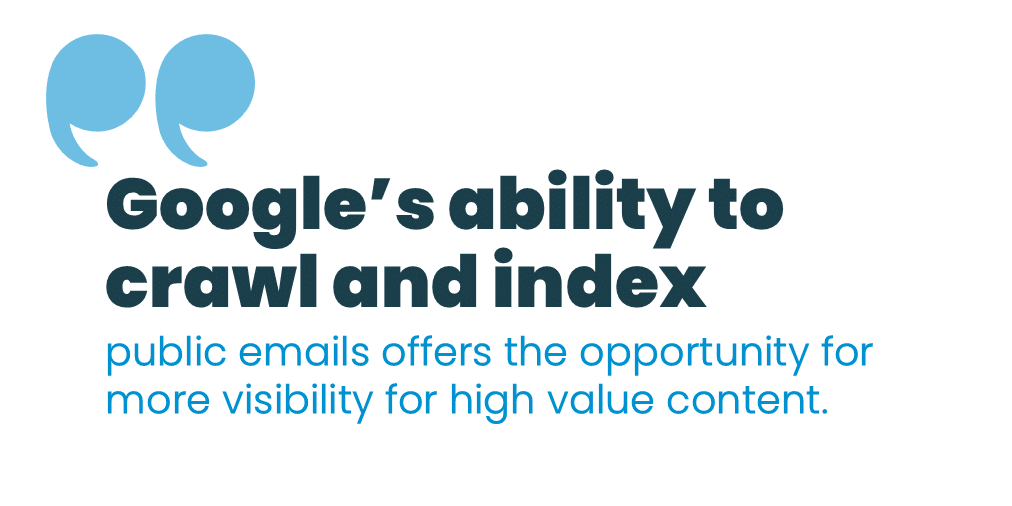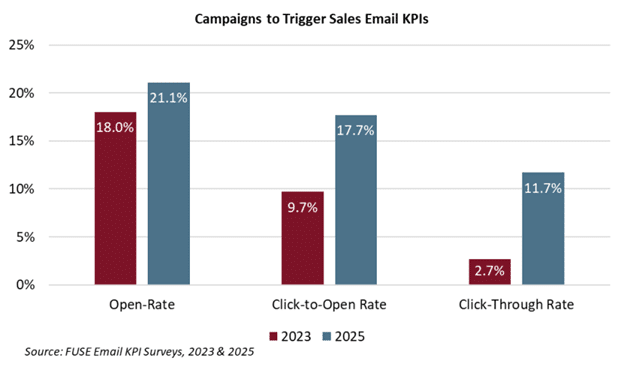
How would email SEO work for investment firms?
Key takeaways:
• Asset manager sales-focused emails are outperforming vs. 2023
• Google’s ability to crawl, index public emails offers more visibility for high value content
• The many open questions argue in favor of proceeding carefully
Those of us focused on content publishing are painfully aware that some of our best content never graces the website.
This is increasingly true as brands and affiliated individuals engage on social platforms.
But two recent news updates have me thinking more about the content that’s shared by asset managers and advisory firms via email.
In this industry, there’s no more powerful and consistently effective marketing channel than email, certainly for financial advisors and other professional investors. (Consumers value email too, according to the Global Consumer Products Engagement Report published last month.)
The latest proof of that comes from a FUSE survey that compared the 2025 vs. 2023 performance of email campaigns aimed at triggering sales—what FUSE defines as the promotion of a specific purchase decision by an advisor.

Well done, marketers! Check out the improvement across the board. (Don’t get hung up by the absolute values shown here, by the way. These are likely an aggregate across all channels, all types of products, quality of relationships, etc. Because you likely email to specifically segmented lists, your numbers will certainly vary.)
Here’s FUSE’s interpretation:
- Campaigns emphasizing urgency and relevance resonate with advisors, who are prepared to act quickly on market opportunities.
- Volatile markets further enhance the appeal of timely investment recommendations, as advisors seek allocation adjustments.
- High click-to-open rates for sales-trigger campaigns indicate that the content is effective and can contribute to gross sales generation.
If such email content directed at the names in your CRM is effective, wouldn’t it be interesting to give that content, or even just timely market content, broader reach while boosting your brand’s visibility at the same time? That’s what immediately jumped to mind when I read about Google’s new ability to crawl and index publicly accessible marketing emails.
Online merchants are the immediate focus of this initiative because there’s the potential for promotions found in email to display in Google Shopping and Maps. They will control Google’s access through a setting in the Google Merchant Center, where most investment firms do not have accounts.
However, upon further review, this could also be an opportunity for non-ecommerce brands. It could be a way for the timely, relevant market content your firm creates and distributes via email to be surfaced in Google search results. So, while what you say in your email may not be on your website, it could support the site by raising awareness and driving traffic—it’s email SEO. What’s not to love?
Envisioning a test—and where we get hung up
Except...crawl, do not run on this. There’s no good reason to jump out on the bleeding edge. Here’s my current effort at stepping through how I think this could work, but also where I get hung up. I’m hopeful that additional information and others’ real-life experiences will close some of the information gaps and ultimately reveal email SEO as a viable pursuit for investment marketers.
- What email content would you want Google to index? It wouldn’t be content created for investment professional-use only. That eliminates some firms but not ETF issuers or others that create emails with content approved for use with the public.
What list would you email to? While you may have other lists that you use for communicating with the public, they may already be scheduled to receive dividend announcements, invitations to events, etc. I’d create a special list just for this purpose. It could be a mix of advisors and the public. And then add marketingemailtogoog@gmail.com. You’d want to send this group—now including the email address of the world’s largest search engine—a single content email to start.
Where I get stuck: You’re adding a non-human email address that did not opt-in and will not likely engage in a traditional way. This could be a violation of your marketing platform. It will be interesting to see how others overcome this.
- How would you prepare to track a single content-rich email sent to the list including Google? Of course, the content should include links to your website that include UTM parameters or other tracking that will enable you to identify the medium (email).
Where I get stuck: How will you be able to isolate the traffic that comes from appearing in search from what’s clicked on by email recipients? At this point, from what I understand, your only option may be to do a manual search check—enter the exact email subject line in Google’s search box and hope to find a search result. That’s wholly unsatisfying for reporting purposes.
You might be tempted to send the email to just Google as a single recipient. Don’t do that, though, as it could trigger all kinds of flags.
- Upon receiving the email you'd send, according to the documentation, Google will scan the email for promotional content (you won’t have the discount offers, etc. that online sellers will), product updates, social media links, visual assets and brand personality—and index in search results. Structuring the content would help Google’s extraction.
- Once you completed the send and nothing blew up, you’d likely need to do a few more tests in order to better understand the pick-up in your brand visibility. If it’s additive, great. If not, deleting the list altogether should stop the experiment. Something to check, regardless: Make sure that no one has inadvertently added the Google email address to the CRM somewhere along the way.
Thoughts, more questions, or do you just want to talk emailing for emailing’s sake as opposed to for email SEO? Drop us a note.
Subscribe.
Receive the latest news and insights from Lowe Group.